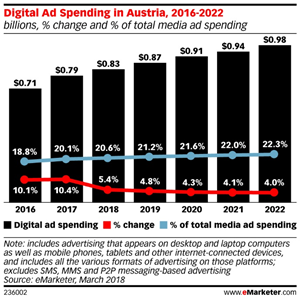Digital, mobile and social media usage in Austria is widespread, but consumers place higher trust in traditional media, according to eMarketer’s latest forecast.
The marketing analytics firm estimates nearly 79% of the population in Austria will use the internet regularly this year, slightly above the average for Western Europe.
In addition, thanks to competing mobile operators and increased 4G coverage and speeds, the number of smartphone users in Austria has risen and now makes up more than 82% of all mobile phone users.
However, while digital usage rates are up, consumers are savvy about digital privacy and wary of content on social media, leading advertisers to spend cautiously on social platforms. This translates to low overall digital ad spending.
Emarketer expects digital will capture 20.6% of total media ad spend in 2018, the lowest share in Western Europe. That figure is expected to grow to just 22.3% in 2022, meaning traditional media will dominate Austria’s ad market throughout the forecast period.
“Austrians are some of the least trusting of news on social media in Europe. The lack of trust has spilled over into advertising on those platforms, so it’s no wonder that advertisers are hesitant to spend on social,” said Jasmine Enberg, forecasting analyst at eMarketer. “Instead, they continue to direct their ad budgets toward print because of high consumer trust in traditional newspapers and strong readership rates.”
Methodology
eMarketer’s forecasts and estimates are based on an analysis of quantitative and qualitative data from research firms, government agencies, media firms and public companies, plus interviews with top executives at publishers, ad buyers and agencies. Data is weighted based on methodology and soundness. Each eMarketer forecast fits within the larger matrix of all its forecasts, with the same assumptions and general framework used to project figures in a wide variety of areas. Regular re-evaluation of available data means the forecasts reflect the latest business developments, technology trends and economic changes.
